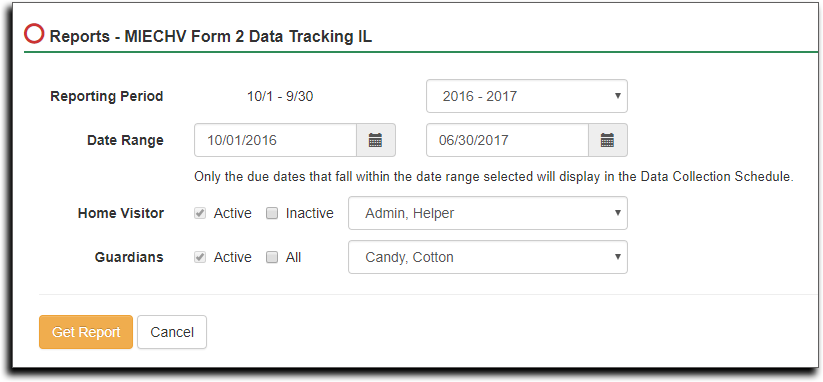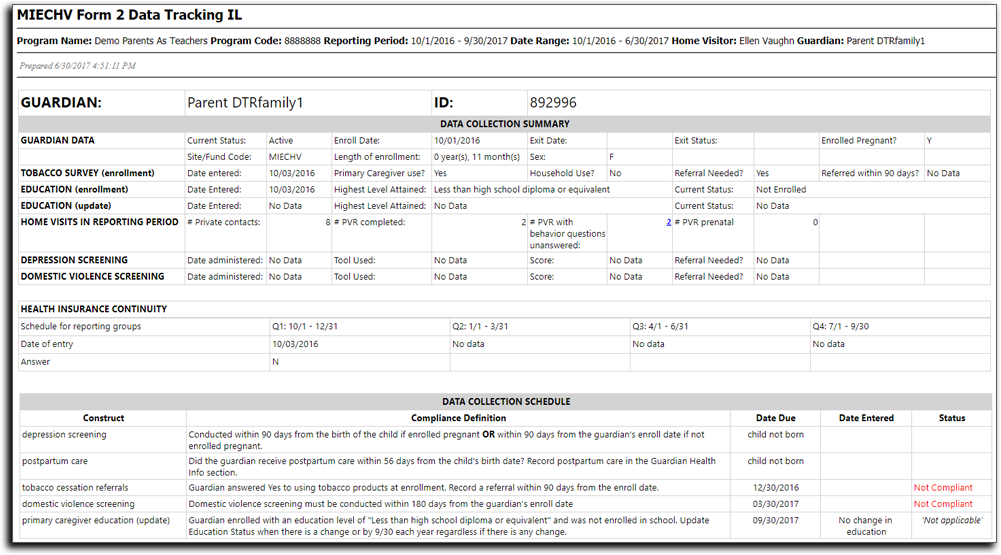A new report has been released today – MIECHV Form 2 Data Tracking IL report. This report is designed to assist the programs and home visitors to keep track of their MIECHV Benchmark (Form 2) data collection. This report is specifically designed based on Illinois’ benchmark reporting plan but may be a useful for programs outside Illinois.
REPORT SUMMARY
- Purpose – Provide home visitors and admins a way to track data entered and be aware of upcoming deadlines for each family being served
- Content – 2 parts to this report for each family member enrolled
- Data Collection Summary – This section will summarize the data collected for each individual that relates to the benchmark requirements
- Data Collection Schedule – This section will display the dates when collection is due, the dates when the data was entered, and indicate whether that item complies with the requirements
UNDERSTANDING THE REPORT
REPORT FILTERS
- This filter will allow you to select the reporting year that you want to review for each family.
- The start and end dates will always be 10/1 – 9/30 to line up with federal reporting requirements
- Currently, 2016-2017 is the only selection. On 10/1/2017, 2017-2018 will be added to the selection list.
- Data Collection Summary – not all items in the summary are dependent on this filter. For example if guardian was enrolled 10/1/2015, the Summary will display enrollment entries from when the guardian was first enrolled such as tobacco use. But other items such as Home Visits, Health Insurance Continuity, and Child Emergency Room will reflect data collected within the reporting period.
- Data Collection Schedule – The Date Range (explained next) will work along with Reporting Period. Only items with due dates that fall within the reporting period will show.
Date Range
- This filter allows you to filter the Collection Schedule.
- Only the items that have due dates that fall inside the date range, OR are prior to the start date of the date range, will show on the report for the guardian and child(ren).
- This filter allows you to reduce how many items you want to look at in the schedule. You may choose a date range that falls before and after the date of your next home visit to help you prepare for that visit. NOTE – Don’t select too small a date range. You may want to set the end date of the range to be a month or so after the home visit just in case there are due dates that fall in between visits.
Home Visitor
- If you are a home visitor logged in, you will only see your name.
- For program admins, you will be able to select the home visitor you want to review.
- Click “Inactive” to include the names of any home visitors that were deactivated but may have been serving families during the reporting period you are viewing
Guardians
- Only the guardians that have a child assigned to the home visitor selected in the Home Visitor filter will be shown in the drop-down list
- The Guardians list will default to only showing the guardians whose current Status = Active
- Click “All” to also include the guardians whose Status is other than Active
- For the guardian selected, the report will show the guardian and all children enrolled under that guardian
DATA COLLECTION SUMMARY & SCHEDULE
The Summary section is going to display the data entered that relates to your required Form 2 (benchmark) reporting.
“No Data” – This will display if there is no entry recorded OR, in the case of the screenings, the date the screening was conducted is out of compliance as seen in the Data Collection Schedule for this report illustrated.
In the HOME VISITS IN REPORTING PERIOD, the information displayed is only for the reporting period selected in the filters. Click on the number for “# PVR with behavior questions unanswered” to get an excel file listing the visit records.
The HEALTH INSURANCE CONTINUITY section is not going to be seen in the Collection Schedule but will show the quarter schedule for collection requirements in the Summary section. This will also be similar to how Well Child and Child Medical Visits work in the Summary section for the child.
Here’s an example of the Child section for this report. There are many more items to specifically pay attention to with Well Child Visits and Developmental Screenings having very specific requirements and age ranges for collection.
This a complex report with many moving parts. It’s also not like any other report in Visit Tracker. As you become familiar with it, let us know how well it is working. If you see anything that doesn’t make sense or data not reporting as expected, tell us. It’s important – as everything we do – that it’s valuable to your work and makes things a little easier.


